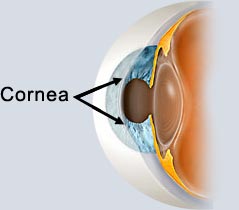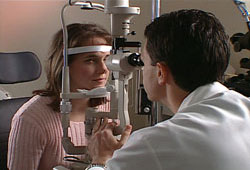The cornea is the clear front window of the eye. It transmits light to the interior of the eye allowing us to see clearly. Corneal disease can cause clouding, distortion and eventually blindness. There are many types of corneal disease.
Symptoms of corneal disease:
- Blurred vision
- Ghost images or haloes around lights
- Sensitivity to bright lights especially outdoor sunlight
- Sensation of a foreign body or object in the eye
- Moderate to severe pain
Causes of corneal disease:
- Infection: Bacterial, fungal and viral infections are common causes of corneal damage
- Herpes simplex in the eye
- Foreign material in the eye such as grass, debris, or metal
- Chemical injury, such as the wrong contact lens solution or household cleaners
- Hereditary corneal dystrophies like Anterior Basement Membrane, Granular or Lattice dystrophy
- Contact lens over-wear or poor cleaning techniques
- Eye trauma from a blunt blow to the eye
- Systemic diseases
Some other corneal conditions:
Keratoconus is a weakening and thinning of the central cornea. The cornea develops a cone-shaped deformity. Progression can be rapid, gradual or intermittent. Keratoconus usually occurs in both eyes, but can occur in only one eye.
Fuchs' endothelial dystrophy is a hereditary abnormality of the inner cell layer of the cornea called the endothelium. The purpose of this layer is to pump fluids out of the cornea, keeping it thin and crystal clear. When the endothelium is not healthy, fluids are not pumped out and the cornea develops swelling, causing it to become cloudy and decrease vision.
Bullous keratopathy is a condition in which the cornea becomes permanently swollen. This occurs because the inner layer of the cornea, the endothelium, has been damaged and is no longer pumping fluids out of the tissue.
Diagnosing corneal disease:

Your eye doctor can check for corneal disease and trauma by examining your eyes with magnifying instruments. Using a slit lamp and advanced diagnostic technology such as corneal topography, your doctor can detect early cataracts, corneal scars, and other problems associated with the front structures of the eye. After dilating your eyes, your doctor will also examine your retina for early signs of disease.
Treatment for corneal disease:
As with any serious eye infection, corneal disease should be treated immediately. Foreign bodies can be removed in the office, and infections treated with new generation antibiotics, steroids, and antiviral agents. Rarely, corneal transplant may be necessary to restore vision when the cornea becomes clouded.